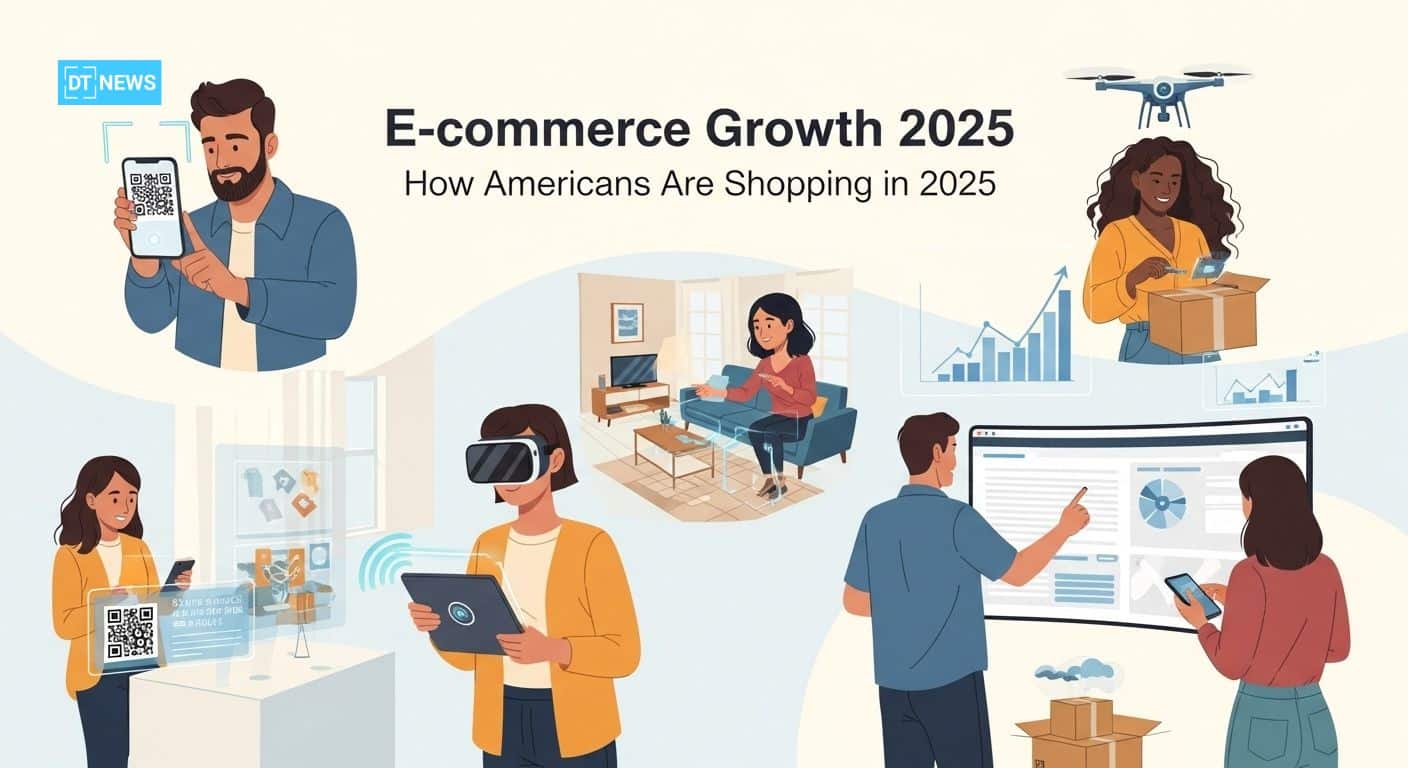This article was first published on Deythere.
E-commerce growth is on fire in 2025. U.S. online sales are growing faster than overall retail, reaching around $304 billion in Q2 2025 (5.3% year-over-year) and 16.3% of total retail.
A great number of Americans are now shopping online; in fact, nearly half of the population are making at least a weekly online purchase. As at 2024, US e-commerce sales had surged to a $1.19 trillion, a whole 8.1% up on the year before.
These numbers are a clear indication that e-commerce is getting bigger and better, with steady, impressive growth. Over the course of 2 years; the online share of US retail went from around 14.7% in 2022 to 16% in 2025.
E-commerce 2025: Online vs. In-Store Sales
It looks like e-commerce might just be outpacing in-store sales. The Census Bureau says that e-commerce growth in Q2 of 2025 was 5.3% year-over-year, and that was 1.4% more than the whole retail sector managed.
All of which points to the online share of retail creeping up further. By last year, e-commerce had reached 16.1% of all sales, up from 15.4% the year before. Retailers say December 2024 was a record with 21.2% of sales online and early 2025 held at 19% online.
However, in-store shopping still rules, 80-81% of purchases are projected to be in physical stores in 2025. In fact, buyers are five times more likely to shop in stores than online. The picture is one of fast online growth but traditional retail still accounts for most of the sales.
Researchers say the e-commerce boom is across the board. Every major retail category is seeing online sales growth. For example, clothing/general merchandise online sales were $53.8 billion in Q2 2025 (11.2% growth from Q2 2024).
Furniture, building materials, and consumer electronics online sales were $30.1 billion in Q2 2025 (8.1% YoY).
Even big-ticket items like motor vehicles saw e-commerce growth; $17.2 billion in Q2 2025 (15.9% YoY).
These category trends show Americans are using the internet for everything from clothes and home goods to cars and appliances.
| Category (Q2 2025) | Online Sales (USD) | Change YoY |
| Clothing and General Merchandise | $53.8 B | +11.2% |
| Furniture / Electronics / DIY | $30.1 B | +8.1% |
| Motor Vehicles & Parts | $17.2 B | +15.9% |
Consumer Demographics and Behavior
Younger shoppers are driving most of the growth. Surveys show young groups shop online way more than older groups. In fact, Gen Z has the highest daily online shopping rate of all generations.
Nearly half of the population are shopping online at least weekly, up from 29% in 2020. Price and value matter also as consumers are cautious with inflation concerns.
In a recent survey; 70% of Americans said they are very concerned about inflation and many are prioritizing deals and discounts. But discretionary categories (electronics, fashion, home goods); are still pulling ahead online.
Younger Americans are also ordering online grocery delivery more. One-third of Gen Z and Millennials are ordering groceries or personal care products online regularly.

Demographics also show a rural-urban divide. People in less urban states shop online more because there are fewer local stores. For example, Hawaii has the highest per-capita e-commerce spending in the country at $24,425/year and North Carolina, a traditionally rural state, has the lowest.
Independent retailers are also concerned. A 2024 survey found 62.7% of store owners cited online competition as their top worry; up from 25% two years ago.
But there’s some balance, 45% of consumers shop in stores first and 72% visit a store weekly. This hybrid behavior suggests many Americans research online and buy in-store or vice versa.
Mobile and Technology Trends
Mobile devices are driving most of the growth in online shopping. Recent data shows over 70% of e-commerce traffic is from smartphones or tablets.
For example; Shopify reports 77% of e-commerce website visits are mobile in 2025. In the US, 80% of households own a smartphone and most internet users have bought something on their phone recently.
Mobile optimization is important as 84% of users will abandon a shopping site after a bad mobile experience; that’s why retailers are investing heavily in fast and user-friendly apps and sites.
Artificial intelligence and data analytics are also changing how users shop. Online stores are using AI to personalize recommendations and ads.
Interestingly, 60% of US consumers now use AI chatbots like ChatGPT or Google Gemini for product ideas or deals. In practice, many consumers will ask an AI assistant where to find the best price on a laptop or what to buy as a gift, and then complete the purchase on the merchant’s site.
Augmented reality technology is starting to make an appearance on retail apps too. With virtual try on glasses and the ability to visualize furniture in one’s own home. Social media and digital video (TikTok and Instagram Reels) aren’t just innovating purchases; they are making it increasingly hard to tell where entertainment ends and shopping begins.
All these trends mean Americans are buying online more and more often.
Payments and New Shopping Models
New payment methods and financial tools are also growing in e-commerce. Digital wallets like Apple Pay, Google Pay, PayPal and retailer apps are used in most online purchases.
In fact, consumers are twice as likely to pay online with a digital wallet as they are in a store.
Buy-Now-Pay-Later (BNPL) plans like Klarna, Afterpay are on the rise. About 15% of Americans used BNPL in the past year, up from 14% in 2023.
Younger and lower-income shoppers use BNPL most, 19% of those within the ages 18-44 reported BNPL use.
Over half of BNPL users said they needed it because it was the only way they could afford the purchase. These installment options are most popular for online-only purchases of fashion and electronics.
Crypto is a small but growing part of e-commerce. Surveys say around 14% – 28% of Americans have crypto, but only a few have used crypto for real-world purchases.
High-end retailers and travel companies are now starting to accept cryptocurrencies and crypto cards. And as regulations get easier to work with; more and more US e-commerce sites are starting to get in on the action. Experts say to expect seeing even more of the reasons that make consumers want to shop online; like loyalty programs , one click check out and subscription models like auto-delivering groceries.
E-commerce Growth 2025 Drivers
Experts agree the US e-commerce market will continue to grow; maybe not explosively. Experts say inflation and tariffs will temper growth, but the National Retail Federation expects modest holiday sales increases.
However, even modest growth means big dollars online. Consumer research firm ThinkNow says nearly half of Americans shop online weekly and hybrid shopping is now normal.

Clothing may start online and finish in-store or vice versa; and younger generations are buying more online including groceries and beauty products.
Retail strategist analysis says omni-channel is essential. While pure online players suddenly find themselves opening pop-up stores, physical stores are also ploughing resources into their digital infrastructure in an effort to stay relevant and not get left behind.
E-commerce is pretty much dominated by Amazon but big retailers like Walmart and Target are rapidly closing the gap. Experts seem to agree that agility when it comes to running an operation; that is quick shipping, and seamless checkouts, will be the key to keeping ahead in 2025.
A report from Crypto.com suggests that using digital payments/ wallets and cryptocurrencies can bring up to 11% more in e-commerce revenue.
Putting all this together, new payment methods, the changing demographics and technological advancements (like mobiles and AI) will be the ones driving e-commerce growth as the years go by. And the retailers who can get on top of data, make the most of mobile shopping and offer shopper-friendly payment options would get the lion share of growth.
Conclusion
E-commerce growth in 2025 just keeps on unfolding. Americans are now shopping online more than ever before – around 16% of all retail sales in 2025, up from just 15% a few years back. This shift is largely being driven by the younger, mobile-first customers, and the new tech that comes with it like mobile apps, AI assistants and digital payment options.
To top it all off, new financial tools like buy-now-pay-later plans, even the use of cryptocurrency, are making online shopping more appealing to consumers. However, most Americans still like shopping the old-fashioned way in a physical store and as a result, retailers are chasing to offer both an online and offline experience.
Analysts are predicting that 2025 e-commerce growth will be all about offering customers what they want: a shopping experience that’s tailor-made for them, convenient, and good value.
Glossary
E-commerce (Electronic Commerce): buying and selling of goods online. In retail, e-commerce is the same thing as online sales through websites or apps.
Omnichannel Retailing: a shopping experience where online meets offline combining online (web, mobile) and offline (physical store) channels.
Digital Wallet: a way to pay online ( Apple Pay, Google Pay, PayPal) that saves user credit card or bank info digitally for painless online checkout.
Buy-Now-Pay-Later (BNPL): a way to buy something online and pay for it over 4 interest-free installments. It’s like a short-term loan.
Average Order Value (AOV): the total amount of all orders made online
Frequently Asked Questions About E-commerce Growth 2025
What is the rate of e-commerce growth in 2025?
In the beginning of 2025; US online retail experienced a growth of around 5% year-on-year. This growth was roughly double the total retail growth rate. Global forecasts predict 6-7% or even more e-commerce growth but the US market might experience slightly slower growth due to market saturation and economic factors.
What is the percentage of online retail in the U.S.?
Online shopping represents around 16-17% of the total US retail sales. This is an increase from approximately 15% from the year 2023. The highest online share was reached in the holiday season of 2024; over 21% for one month; but the overall online share is stabilizing around 16%.
Which categories register the highest growth rate in online sales?
The most popular online sales categories are clothing and general merchandise. Electronics, furniture, and home goods; also contribute to the online growth. Even large purchases like cars are showing strong online growth too.
How do Americans make online payments in 2025?
The use of digital wallets such as Apple Pay and Google Pay; along with retailer apps, is prevalent among consumers for online purchases. Buy-Now-Pay-Later plans are particularly popular among young and low-income shoppers. A small yet growing group of people are using cryptocurrency for their transactions. Traditional credit/debit cards are still widely used; but new payment methods are on the rise.



















































































































